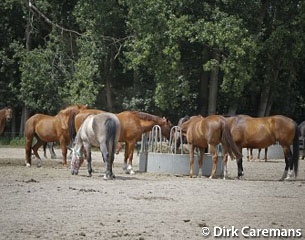
The equine genetics research group at the University of Minnesota College of Veterinary Medicine is collaborating with Ray Geor, BVSc, MVSc, PhD, Dipl. ACVIM, professor and chair of the department of large animal clinical sciences at Michigan State University
, and Nicholas Frank, DVM, PhD, Dipl. ACVIM, associate professor of large animal clinical sciences at the University of Tennessee, to investigate the occurrence and genetics of equine metabolic syndrome (EMS). Bob Coleman, PhD, PAS, associate director for undergraduate education in equine science and management and extension horse specialist at the University of Kentucky also is involved in the study.
EMS is a condition characterized by obesity and/or regional adiposity (cresty neck), elevation of blood insulin levels, and increased risk for laminitis development. Certain horses that seem predisposed to EMS often are referred to as "easy keepers.” These horses are very efficient at utilizing calories and often require a lower plane of nutrition to maintain body weight than other horses. This difference in EMS susceptibility among horses managed under similar conditions is likely the result of a genetic predisposition.
The goal of this investigation is to better understand the role of breed, gender, age, environment (diet and exercise), and genetics in EMS. The success of the study depends on the collection of data from as many horses with EMS as possible; therefore, horse owner and veterinarian assistance is critical.
Thus far, more than 500 horse owners have provided information about their horses, which has already helped increase the research team's understanding of EMS and laminitis. However, to meet all of the team's research goals, they need many more horse owners' help. The researchers' aim is to identify genetic markers that will predict a horse's risk level for developing EMS and laminitis before clinical signs manifest, allowing owners and veterinarians to initiate management practices that better protect their horses from developing disease.
Participation in the study involves three steps:
- 1. Fill out a brief, 10-question survey located at study's website.
- 2. If the horse is selected as a potential candidate, the owner will be sent a link to a second online survey requesting additional information regarding diet and exercise, a few simple body measurements, and photos of the horse suspected of having EMS, in addition to photos of another horse on the property not suspected of having EMS to serve as a "control."
- 3. Owners of horses selected for inclusion in the genetic study will be asked to work with their veterinarian to provide a blood sample (that will be analyzed free of charge) and include testing for insulin, glucose, ACTH, and lipids; and submit feed, hay, and pasture samples that also will be analyzed free of charge (both owner and veterinarian will receive notification of the results). A portion of the blood sample will be used for DNA isolation and stored for genetic research.
Horse owners assisting in the project will be providing information essential to further understanding of EMS and ultimately determining ways to better manage and treat affected horses. To learn more about the equine metabolic research project and how you can help make a difference in the welfare of many horses, visit the study's website at www.cvm.umn.edu/equinegenetics/ems/home.html.
Photo © Dirk Caremans